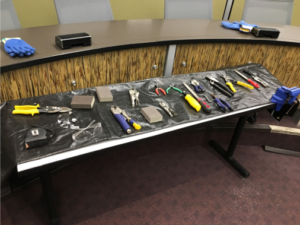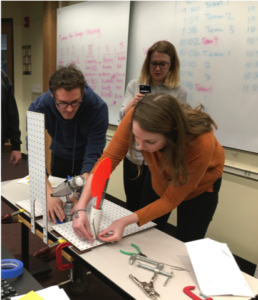This post was written by Ian Dechow ’18 and Randy Baron ’18
Entering Kalkin 110 on a particular mid-April day was unlike any day before it; a lively if not curious environment awaited inside the classroom.
 Against the auditorium style seating a table was set up and laid out with what could be confused as the tools from Dexter’s laboratory, a motley assortment of pliers, saws, metal files, and safety goggles were spread over a black tarp. On a second look around the room you notice a type of pinball style launching devices affixed to the front desk, a ping pong ball loaded into its cartridge, aimed at narrow vertical strip of peg board. On the ground in front of the desk beyond the pegboard barrier were two lines of tape outlining what we would come to learn was a landing strip of sorts. We were not sure what to think of this odd display as we took our seats, but were quickly informed by the excited and jovial explanation from Mike Rosen, our guest lecturer for the day.
Against the auditorium style seating a table was set up and laid out with what could be confused as the tools from Dexter’s laboratory, a motley assortment of pliers, saws, metal files, and safety goggles were spread over a black tarp. On a second look around the room you notice a type of pinball style launching devices affixed to the front desk, a ping pong ball loaded into its cartridge, aimed at narrow vertical strip of peg board. On the ground in front of the desk beyond the pegboard barrier were two lines of tape outlining what we would come to learn was a landing strip of sorts. We were not sure what to think of this odd display as we took our seats, but were quickly informed by the excited and jovial explanation from Mike Rosen, our guest lecturer for the day.
Mike, an engineer and Research Associate Professor at University of Vermont, had come to the Grossman School of Business to teach a workshop on Design Thinking for The Sustainable Innovation MBA 2018 cohort. Mike, after telling us a little about his background, passed out an eclectic set of supplies to the pre-divided teams and told use what the challenge for the class would be. Using the launcher at the front of the room, the tools, and materials provided: pegboard, small metal sheets, PVC piping, ping-pong paddles, and various other connector type elements, we were to construct a device to divert a ping-pong ball around, over, or through the vertical pegboard barrier and land within the landing strip on the ground designated by red tape. Each team after understanding the challenge would get opportunity to ideate, prototype and test a device in order to achieve the unconventional task.
 Design Thinking was a term coined in the mid-sixties by L. Bruce Archer and later refined for the business world by IDEO founder David M. Kelley in the early nineties. Design Thinking is a term for human-centered design and innovation which focuses an iterative method on solving wicked problems. The Design Thinking approach is a chaotic overlapping process that cycles through three main stages in no exact order: inspiration, ideation, and implementation. In the inspiration stage you seek to empathize, understand and define the challenge you are trying to address. In the ideation stage, you iterate and prototype. Finally, in the implementation stage you test and pilot the prototype before starting all over to try to refine the product even more. The Design Thinking Process can be a frustrating one but it has been shown to be an effective method for solving difficult problems as well as a strong tool for co-creation.
Design Thinking was a term coined in the mid-sixties by L. Bruce Archer and later refined for the business world by IDEO founder David M. Kelley in the early nineties. Design Thinking is a term for human-centered design and innovation which focuses an iterative method on solving wicked problems. The Design Thinking approach is a chaotic overlapping process that cycles through three main stages in no exact order: inspiration, ideation, and implementation. In the inspiration stage you seek to empathize, understand and define the challenge you are trying to address. In the ideation stage, you iterate and prototype. Finally, in the implementation stage you test and pilot the prototype before starting all over to try to refine the product even more. The Design Thinking Process can be a frustrating one but it has been shown to be an effective method for solving difficult problems as well as a strong tool for co-creation.
 After the class understood the task, we separated into our teams and begin brainstorming solutions to the challenge set before us. The class quickly realized each team would need to be allotted time with the pinball launcher to test their designs. We created a rotating schedule so each team could test and improve upon their designs. Each team only had a few minutes to test before having to go back to the drawing board to integrate what they had learned using their new-found knowledge to guide their prototyping.
After the class understood the task, we separated into our teams and begin brainstorming solutions to the challenge set before us. The class quickly realized each team would need to be allotted time with the pinball launcher to test their designs. We created a rotating schedule so each team could test and improve upon their designs. Each team only had a few minutes to test before having to go back to the drawing board to integrate what they had learned using their new-found knowledge to guide their prototyping.
Each group came up with ingenious means of circumnavigating the obstacle. One group in particular was prolific coming up with two unique designs. The first of these consisted of a ping pong paddle angled in a way that allowed the ping pong ball, when fired, to bounce around the barrier. The second design used packaging materials to create a tunnel that allowed the ball to go under the barrier. Another group used a curved piece of metal, forming a chute, that propelled the ball around the barrier. We impressed each other and ourselves with out of the box designs.
The Design Thinking iterative process provided a creative mindset that allowed us to solve an engineering challenge without using complex mathematics. In the end, every group was successful in completing the challenge. Mike was impressed by our teamwork and listening skills. He pointed out that this was the key to success when working under real world constraints such as limited time and scarce resources, circumstances he tried to mimic when designing the challenge.
Solving wicked problems is difficult because the answer is never perfect. Sometimes, the most challenging part is just starting the process, which is where Design Thinking is most handy. Mike told us a story before we parted ways. He told us about a group of students that were presenting their senior project; they came up with a brilliant design that solved a real-world problem. However, their work was frowned upon by other faculty because it did not include any of the complex mathematics they were paid to teach. The lesson here is that engineering isn’t always about numbers, it’s about not being afraid to pick up some tools and just begin the work, even if you know you might not get it right. Go out and get your hands dirty solving a challenging problem. This notion speaks to what it is to be a Sustainable Innovation MBA student. The Sustainable Innovation MBA is about cultivating the confidence to get people out in the world to solve wicked problems, those problems without solution that must be solved. Being in this program is about getting your hands dirty, without fear of failure, to make the world a better place.
